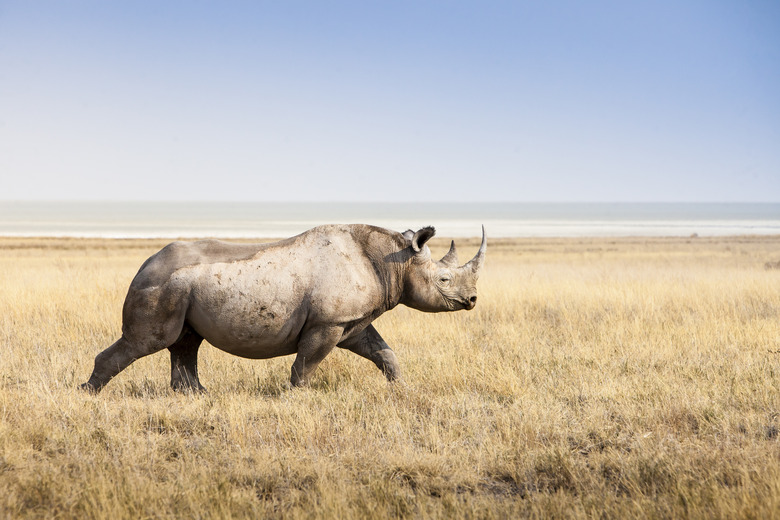What Do Rhinos Use Their Horns For?
Rhinoceroses are large mammals most known for the distinguishing horn on their snout. Three species of rhinoceros have two horns with the front horn growing quicker and larger. The other two species have a single horn. The World Wildlife Fund classifies the rhinoceros as critically endangered because of slow reproduction, habitat loss and poaching for the horns made of keratin and hair. Some people believe ingesting the horns has health benefits, but the horns are really only beneficial to the rhinoceros itself.
Intimidation & Prowess
Intimidation & Prowess
The main use of a rhinoceros horn is posturing. One male rhinoceros reigns over a clearly defined territory and does not permit any dominant males to enter his area. Hoping to avoid a fight, a rhinoceros lowers its horn to the ground or locks horns with the enemy. A rhinoceros will also lower its head and charge to scare encroaching animals, including other rhinoceroses. The horn is also used as an indicator of a strong mate, so larger horns are more desirable.
Defense
Defense
If intimidation does not forestall a fight, both species of African rhinoceros use their horns to defend themselves. The horns are sharp enough to gore their thick skin because the rhinoceros rubs it on rough surfaces, which inadvertently removes the soft outer layer. Rhinoceroses are also quick runners, so charging is especially damaging. According to the Encyclopedia of Animals, half of male black rhinoceroses and a third of females die from fights.
Digging
Digging
The sharp horn is useful for digging in the dry, compact soils rhinoceros often frequent. If there are not enough grasses available for the white rhinoceros, they use their horn to dig for roots or unearth small plants with edible roots. If no roots are around, they dig to gain access to shorter grasses. When desperate for water, the rhinoceros digs in dry riverbeds to find an underground supply.
Other Uses
Other Uses
Female rhinoceroses use their horns to steer their young and guide them until they are capable of navigating on their own. Male rhinoceros sometimes use their horns to move their excrement into piles that demarcate the border of their territory. The Honolulu Zoo reports that white rhinoceroses use their horns and front feet to test the thickness of a mud hole before entering to cool down. If the mud is too thick, they will not risk becoming stuck.
Cite This Article
MLA
Hippler, Megan. "What Do Rhinos Use Their Horns For?" sciencing.com, https://www.sciencing.com/do-rhinos-use-horns-8069360/. 22 November 2019.
APA
Hippler, Megan. (2019, November 22). What Do Rhinos Use Their Horns For?. sciencing.com. Retrieved from https://www.sciencing.com/do-rhinos-use-horns-8069360/
Chicago
Hippler, Megan. What Do Rhinos Use Their Horns For? last modified August 30, 2022. https://www.sciencing.com/do-rhinos-use-horns-8069360/
